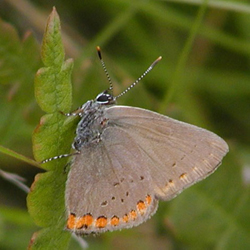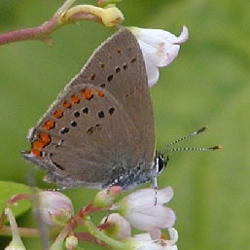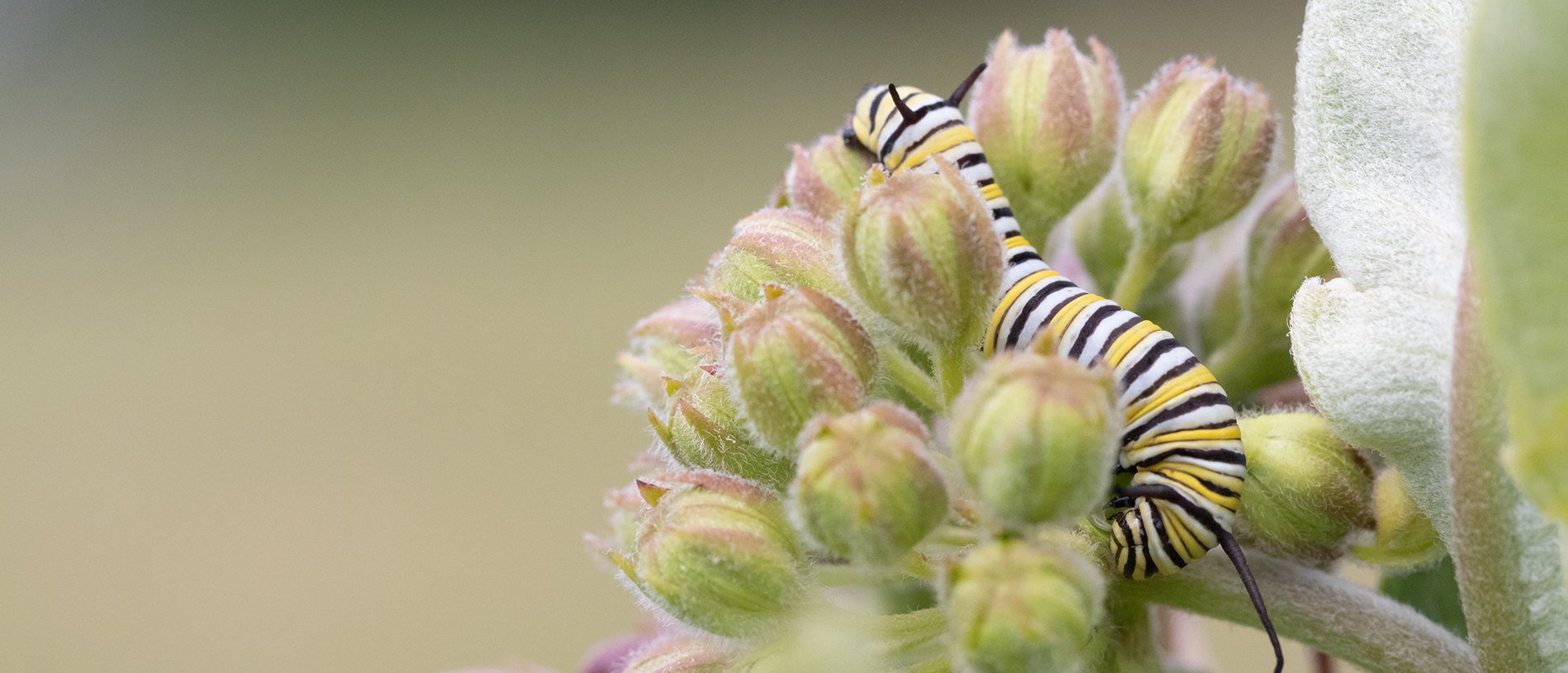Butterfly Atlas
Find a Butterfly
Coral Hairstreak
Satyrium titus
Named
Fabricius, 1793

Identification
Wingspan: 1 - 1 1/4". Easily distinguished from our other brown hairstreaks by three characters: the prominent row of bright coral spots along the outer margin of the hindwing below (never has a blue spot at the end of this row); absence of "tails"; and distinctive clay brown color of the underwings.
Distribution
North America from northeastern British Colombia and Nevada east to Maine and the Florida panhandle; absent from Nova Scotia and the southeastern coastal plain. Occurs throughout New England.
Status in Massachusetts
Uncommon to locally common during the atlas period; apparently relatively scarce in the Berkshires and along the northern border. Scudder‘s account of its status (1889) is very ambiguous: "In New England it is considered a rare insect, but has occasionally been found in considerable numbers and is well distributed, at least over the southern portion. The only northern locality in which it has been found is Norway Maine where it occurred in abundance...in the vicinity of Boston ‘very rare‘". One may guess that its perceived status is related to land use patterns in relation to its preferred habitat. Favoring wild cherries as a food plant and weedy fields as adult habitat, the species fares poorly in densely forested areas and benefits as land is cleared and subsequently reforested. Maximum: 25, Middleboro, 19 July 1990.

Flight Period in Massachusetts
One brood, flying from early July to late August with a peak mid July to early August. Extreme dates: 2 July 1994, Broad Meadow Brook Sanctuary (Worcester Co.), T. Dodd; 5 July 1987, Gill (Franklin Co.), M. Fairbrother; 22 August 1990, Edgartown (Dukes Co.), B. Cassie.
Larval Food Plants
Cherries and plums (Rosaceae). Known host species that occur in New England are: Black Cherry (Prunus serotina), Choke Cherry (Prunus virginiana), American Plum (Prunus americana); also cultivated cherries. Black Chokeberry (Aronia melanocarpa) is also used (Opler and Krizek, 1984). The sedentary caterpillar feeds on leaves and fruit and is tended by ants which feed on its honeydew excretions.
Adult Food sources
Like most hairstreaks, this handsome little butterfly is most obvious on one of its favorite nectaring plants, especially Butterfly Weed, Common Milkweed, Swamp Milkweed, New Jersey Tea, or Meadowsweet. Atlas workers recorded it nectaring on a total of 14 species.

Habitat
Most often found in open weedy areas where its nectar sources occur, especially near upland shrubby areas or wood edges where its food plants are common. Pavulaan notes (pers com) that in Rhode Island ideal habitat consists of places where Black Cherry and Butterfly Weed grow in close proximity.
Life Cycle
EGG: A pale to deep green "cushion" with whitish projections over the whole surface that give the effect of a hoary bloom. OVIPOSITION: Eggs are laid singly on twigs of the host trees or on leaf litter around the trunk. LARVA: When mature, the slug-like larva is green, sometimes yellowish toward the head with a darker green stripe down the back and rosy splotches varying in width which expand posteriorly to cover most of the tip of the abdomen; head black with a pale transverse stripe across the "face". A sedentary caterpillar tended by ants which feed on its honeydew excretions. CHRYSALIS: A smooth brown capsule with darker makings. PUPATION: Presumably on the ground; 12-17 days (Scudder, 1889). OVERWINTERING STAGE: Egg.
The slug-shaped larva hatches in mid-May as cherry foliage begins to emerge and matures around the end of June. Opler and Krizek (1984) note that the male butterflies are "extremely aggressive toward other males and small insects" as they perch conspicuously awaiting passing females.
Account Author
Chris Leahy



